Kongsberg Våpenfabrikk Skarpskyttergevær M59, "Mauser M59"
Kongsberg Våpenfabrikk introduced the M59 (also denoted KV59) in 1959, first chambered in .30-06, but shortly afterwards production was changed to accommodate the new 7.62 NATO round, and M59 rifles chambered for the 7.62 NATO were denoted M59F1. The M59F1 served first as a sniper rifle for the regular armed forces. After the NM149 was introduced, the M59F1 served with the Norwegian Home Guard (Heimevernet) until the 1990s. It was also used as a civilian target rifle, having the advantage over the Krag–Jørgensen M1894 that it did not suffer from changing point of impact in rainy weather. Thus, many shooters had a Krag–Jørgensen for the sunny days and one Mauser for rainy days.
Technical details and images
 Kongsberg Våpenfabrikk used German Mauser 98k actions for the manufacture of the M59. The picture shows a civilian M59.
Kongsberg Våpenfabrikk used German Mauser 98k actions for the manufacture of the M59. The picture shows a civilian M59.
Closeup of the action and re-profiled bolt handle:
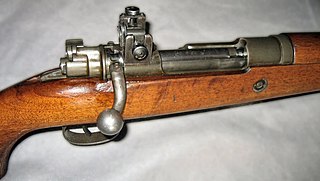
Old markings were removed, and the front receiver bridge was opened to accommodate loading of the somewhat longer (compared to the 7.92×57 mm Mauser) .30-06 cardridge,
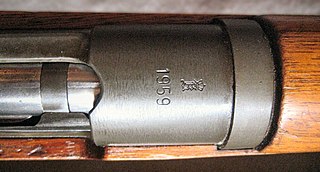
This is also found on the M59 rifles which were re-chambered to the 7.62×51mm NATO cartridge. On the civilian version, only the extractor claw was blued, while the rest of the bolt was polished, while on the army issue M59F1, the whole bolt was blued.
The pistol grip:
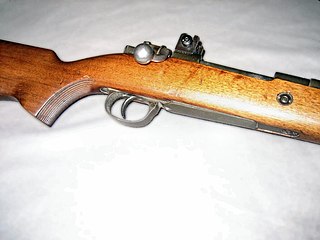
The magazine follower on the 98k would lock the bolt's forward motion on an empty magazine. This feature was retained on the M59:
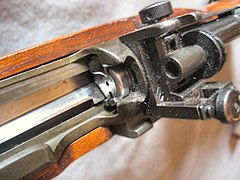
The half-length cleaning rod was screwed into the fore-end. Two to three of these were required to assemble a rod of sufficient length:
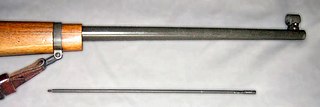
A civilian M59 (top) in .30-06 and the army issue M59F1 in 7.62×51mm NATO (bottom, with a side-mounted scope). Note the blued bolt and absence of the cut-out in the front receiver bridge on the M59F1. Note also the different markings on the front receiver bridge.
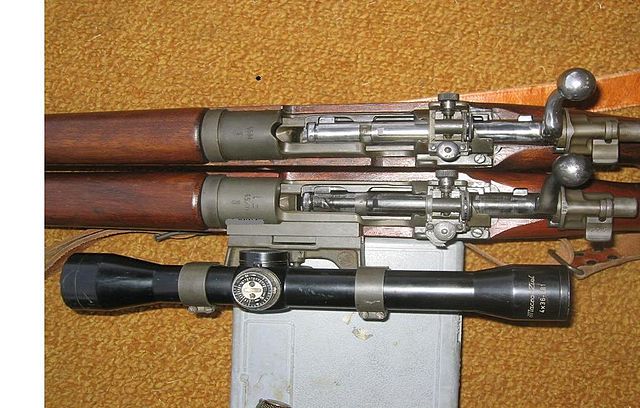
Alternative model designations (unofficial)
- Kongsberg Våpenfabrikk Modell 1959
- Kongsberg-Mauser M59
- KV59
- KV M59
- Modell 1959 Skarpskytter
- Skarpskytterrifle M59
- Skarpskytterrifle Modell 1959

The Krag–Jørgensen is a repeating bolt-action rifle designed by the Norwegians Ole Herman Johannes Krag and Erik Jørgensen in the late 19th century. It was adopted as a standard arm by Norway, Denmark, and the United States. About 300 were delivered to Boer forces of the South African Republic.

The Karabiner 98 kurz, often abbreviated Karabiner 98k, Kar98k or K98k and also sometimes incorrectly referred to as a K98, is a bolt-action rifle chambered for the 7.92×57mm Mauser cartridge. It was adopted on 21 June 1935 as the standard service rifle by the German Wehrmacht. It was one of the final developments in the long line of Mauser military rifles.
The Krag–Petersson was the first repeating rifle adopted by the armed forces of Norway and was one of the first repeating rifles to be adopted as standard issue by a military force, being preceded by the Swiss Vetterli adopted in 1867. Developed by Ole Herman Johannes Krag, the action of the Krag–Petersson was uniquely actuated by an oversized hammer. Another distinguishing feature was that the cartridge rising from the magazine was not seated automatically, but had to be pushed into the breech of the rifle.

The Jarmann M1884 is a Norwegian bolt-action repeating rifle designed in 1878 adopted in 1884. The Jarmann's adoption, and subsequent modifications, turned the Norwegian Army from a fighting force armed with single-shot black-powder weapons into a force armed with modern repeating weapons firing smokeless ammunition. Several thousand were manufactured to equip the Norwegian Armed Forces in the 1880s, and it also saw some, though very limited, use in Sweden. The design is unique, and was the brainchild of Norwegian engineer Jacob Smith Jarmann. After the design had been phased out of the Norwegian Army, a number of the weapons were rebuilt as harpoon guns.

The Remington M1867 was a rolling-block rifle, the first rifle using metallic cartridges to be adopted by the Norwegian and Swedish armies. Nominally it had a caliber of 4 decimal lines, but the actual caliber was 3.88 Norwegian decimal lines or 4.1 Swedish decimal lines (12.17 mm), and it fired a rimfire round with a 12.615 mm lead bullet. The 12.17 mm caliber was chosen because the Swedish army had approximately 30,000 new muzzle-loading M1860 and breech-loading M1864 rifles in 12.17 mm caliber in stock, rifles that were suitable for conversion to M1867 rolling-block rifles. With the exception of the first 10,000 rifles and 20,000 actions, which were made by Remington in the US, all Remington M1867 rifles and carbines were made under license in Norway and Sweden, by Kongsberg Vaapenfabrik in Norway, and by Husqvarna Vapenfabriks Aktiebolag and Carl Gustafs stads Gevärsfaktori in Sweden with the two Swedish manufacturers producing about 80% of the weapons.
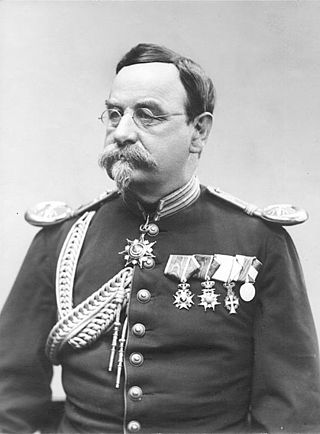
Ole Herman Johannes Krag was a Norwegian officer and firearms designer.

Erik Jørgensen was a Norwegian master gunsmith, well known for his cooperation with Ole Herman Johannes Krag in developing the successful Krag–Jørgensen rifle.

Jacob Smith Jarmann was a Norwegian firearms designer and inventor of the Jarmann rifle.

6.5 × 55 mm Swedish, also known simply as 6.5×55mm, or in its native military as 6,5 mm patron m/94, meaning "6.5 mm cartridge model 1894", is a first-generation smokeless powder rimless bottlenecked rifle cartridge. It was introduced in the 1890s, and is still one of the most common cartridges in modern rifles built for the Scandinavian market today. The cartridge was developed in a joint Norwegian and Swedish effort starting in 1891 for use in the new service rifles then under consideration by the United Kingdoms of Sweden and Norway. In 1893, the cartridge was standardized and adopted under the name 6.5×55mm to facilitate logistical cooperation between Norway and Sweden. The two nations had independent armies and consequently the normal procedure at the time was for their respective governments to use the same ammunition and then purchase small arms of their choice. Norway adopted the Krag–Jørgensen M/1894 rifle, while Sweden adopted the Mauser m/1896 rifle design that was based on a Mauser service rifle designed around the 7×57mm Mauser cartridge.
The NM149 sniper rifle was developed by Våpensmia A/S in close cooperation with the Norwegian Army and is based on the tried and true Mauser M98 controlled feed bolt action. These actions originate from Mauser Karabiner 98k rifles left by German armed forces in Norway at the end of World War II in 1945. It is used by both the Norwegian military and police forces, though it was originally designed at the request of the Norwegian Army. The NM149 replaced the Kongsberg M59F1 in the Norwegian Army.
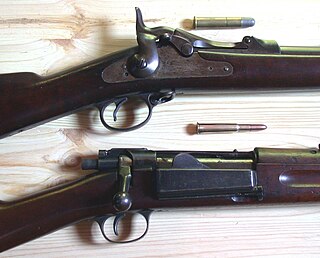
The Springfield Model 1892–99 Krag–Jørgensen rifle is a Norwegian-designed bolt-action rifle that was adopted in 1892 as the standard United States Army military longarm, chambered for U.S. caliber .30-40 Krag cartridges. All versions and variants were manufactured under license by the Springfield Armory between 1892 and 1903 and famously served as the longarm during the Spanish–American War.

"Swedish Mausers" are a family of bolt-action rifles based on an improved variant of Mauser's earlier Model 1893, but using the 6.5×55mm cartridge, and incorporating unique design elements as requested by Sweden. These are the m/94 carbine, m/96 long rifle, m/38 short rifle and m/41 sniper rifle. Production began in 1898 at Carl Gustafs stads Gevärsfaktori in Eskilstuna, Sweden.
The Kongsberg M67 is a bolt-action sharpshooter rifle made by Kongsberg Våpenfabrikk of Norway, based on actions from Mauser M98k left by German armed forces in 1945. The M67 replaced the M59 in 1967 and was produced until the 1990s. The rifle is sometimes unofficially referred to as Mauser M67. However, both M59 and M67 were not licensed products of Mauser, but were produced by Kongsberg and marketed as such.
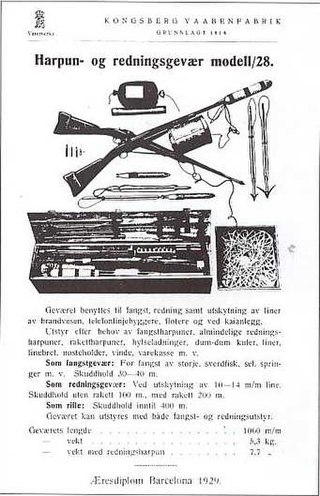
The M28 Jarmann harpoon rifle was a modification of the Jarmann M1884 Norwegian service rifle.
The SIG Sauer 200 STR, also known as the SIG Sauer 200 STR Match, is a bolt-action rifle mostly used as a target/competition rifle for national competitions by Norwegian, Swedish and Danish sport shooters. It is a variant of the Sauer 200 TR or SIG Sauer 200 TR Match rifle that features thicker 19 mm (0.75 in) diameter barrels. The 200 STR is produced by J. P. Sauer & Sohn GmbH in Germany.
The M52 was the first in a family of target rifles based on refurbished Mauser M 98 military actions by the Danish company Schultz & Larsen in the years following World War II. They were produced to fill a need for target rifles by the Danish shooting association - De Danske Skytteforeninger. The M52 was superseded by later variants the last of which remained in production until the 1970s. It had a similar development path to other Scandinavian target rifles derived from German M98 and other Mauser actions, such as the Kongsberg M59 and Carl Gustaf M63.
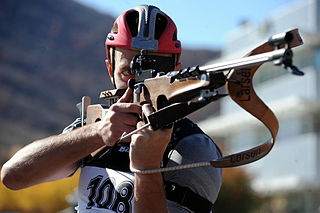
A Biathlon rifle is a specialized rifle designed for use in a biathlon event. Specialist biathlon rifles are ultra lightweight, and usually equipped with straight-pull actions, integrated magazine carriers, and ergonomic stock designs suitable for both prone and standing positions.
SIG Sauer 205 is a bolt-action rifle formerly produced by SIG Sauer. The rifle was produced in several variants for competition shooting and law enforcement.

Unsafe firearm and cartridge combinations are combinations of firearms and cartridges which can cause an unsafe condition for the shooter when firing.
Lakelander and Varberger can refer to several rifles based on the design of Lars Andersson from Sweden. These rifles include the Finnish-produced TAP-375, the Swedish-produced Varberger 757, 717, 711 and 777, and the Norwegian-produced Kongsberg Lakelander 389 and Kongsberg 393. In addition, the Lakelander 375 was manufactured in Finland by TAP, as well as in Sweden by various manufacturers.




















